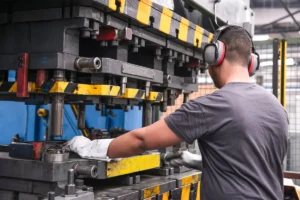Imagine working where the buzz and clang of machinery are part of your daily symphony. It’s vital, then, to consider how this concert affects one crucial audience member: your hearing. This is where ear protection steps onto the stage.
Understanding the Basics of Ear Protection
At its core, ear protection involves devices or measures used to guard the ears from damage due to exposure to loud noises. This can range from simple foam earplugs to sophisticated electronic earmuffs that can filter harmful noise levels while allowing important sounds, like conversations and alarms, to be heard.
Different types of ear protection are designed to fit the specific needs and comfort preferences of individuals, as there’s no one-size-fits-all solution. The effectiveness of these devices is typically measured by their Noise Reduction Rating (NRR), which quantifies the level of sound reduction offered.
The Impact of Noise on Hearing Health
Prolonged exposure to noise levels above 85 decibels, the equivalent of heavy city traffic, can damage the delicate structures inside the ear, leading to noise-induced hearing loss (NIHL). This type of hearing loss is often gradual and can go unnoticed until it is significant.
In addition to hearing loss, consistent exposure to high noise levels can also result in tinnitus, a ringing or buzzing in the ears, and even contribute to stress and hypertension. Protecting your ears is not only a matter of hearing health but overall well-being.
Choosing the Right Ear Protection for Your Workplace
Identifying the most suitable ear protection begins with understanding the specific noise hazards in your workplace. This requires not just a knowledge of the loudness levels but also the duration of exposure and the nature of the noise, whether it’s constant or intermittent.
For environments with variable noise levels, electronic ear protectors can offer a versatile solution, adjusting in real-time to changing conditions. Meanwhile, simpler, disposable plugs might be sufficient for workplaces with consistently moderate noise levels.
Comfort and practicality also play critical roles in choosing ear protection. If the device is uncomfortable or inconvenient, its usage will likely be inconsistent, diminishing its protective effectiveness.
Implementing an Effective Hearing Conservation Program
A comprehensive hearing conservation program goes beyond just supplying ear protection. It involves assessing the sound levels in the workplace, educating employees about the risks of noise, and training them on how to use and care for their protective gear effectively.
Regular hearing assessments can also be part of the program, helping to identify any hearing loss early and adjust protective measures accordingly. Such programs demonstrate a commitment to employee health and can foster a culture of safety and awareness in the workplace.
Navigating noisy workplaces without the right ear protection is like walking into a storm without an umbrella. Just as the umbrella shields you from the rain, ear protection shields your hearing from the damaging effects of noise. It’s not just about safety; it’s about quality of life both inside and outside of work.


